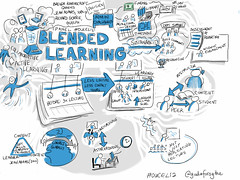 While blended learning** has been around for a while now, it is often the benefits*** that are focussed on rather than some of the issues (including an increased workload for facilitators, technological problems, and poor communication - Garrison & Vaughan, 2007) that providers of blended learning need to be aware of up front, and how these might be addressed to maximise the benefits for learners.
While blended learning** has been around for a while now, it is often the benefits*** that are focussed on rather than some of the issues (including an increased workload for facilitators, technological problems, and poor communication - Garrison & Vaughan, 2007) that providers of blended learning need to be aware of up front, and how these might be addressed to maximise the benefits for learners.The Blended Learning Synchronous Learning project aimed to "identify, characterise, and evaluate technology-enhanced ways of bringing together on-campus and geographically dispersed students and engaging them in media-rich synchronous collaborative learning experiences" (source). As a result of the project, 7 case studies have been developed that "provide a better understanding of the issues that impact on the effectiveness of blended synchronous learning, which in turn can be used to enhance the practice of educators" (source), while also providing "practical guidelines for staff" (source).
The case studies
I'd highly recommend dipping into these case studies if you are already involved in facilitating blended learning, or are thinking about it:- Case 1: Web conferencing to develop investment understanding (collaborative evaluation task)
- Case 2: Room-based video conferencing to develop understanding of healthcare quality improvement approaches (collaborative evaluation task)
- Case 3: Web conferencing to develop microscopic tissue analysis and interpretation skills (group questioning)
- Case 4: Web conferencing for participation in statistics tutorials (collaborative problem solving)
- Case 5: Virtual worlds to facilitate Chinese language learning (paired role-play)
- Case 6: Web conferencing to enable presence in sexology (lecture discussions)
- Case 7: Virtual worlds for teacher education (collaborative evaluation and design)
Footnotes
** Heinze and Proctor (2004) define blended learning as “learning that is facilitated by the effective combination of different modes of delivery, models of teaching and styles of learning, and founded on transparent communication amongst all parties involved with a course” (p. 21)*** Garrison and Vaughan (2007) go on to identify a variety of benefits for learners including:
- increased student use of course resources outside face-to-face sessions;
- opportunities to apply skills, concepts, and theories in authentic contexts;
- opportunities for self-directed learning;
- integration of online and in-class learning; variety of assignment / assessment types and formats;
- flexible access to interactive tools and resources that meet a range of learner needs; and
- further peer to peer interaction and critical dialogue. (Adapted from Garrison, & Vaughan, 2007, p. 35)
References
- Garrison, R., & Vaughan, N. (2007). Blended learning and course redesign in higher education: Assessing the Role of Teaching Presence from the Learner Perspective. Retrieved May 12, 2007, from http://www.ucalgary.ca/
- Heinze, A., & Proctor, C. (2004). Reflections on the use of blended learning. Paper presented at the Education in a Changing Environment, University of Salford, UK. Retrieved June 10 2005, from the Salford University Web site: http://www.edu.salford.ac.uk/her/proceedings/papers/ah_04.rtf.






No comments:
Post a Comment